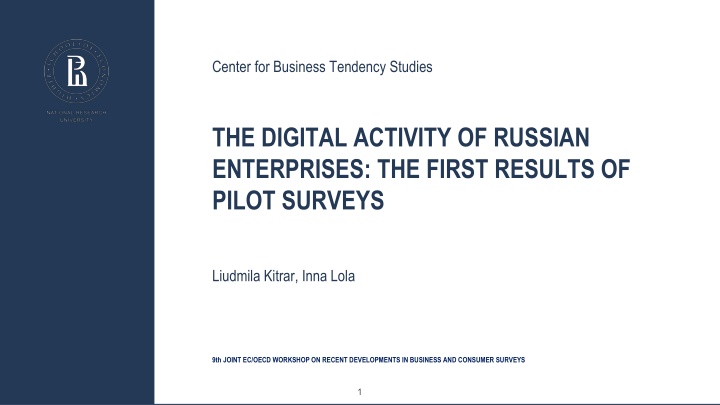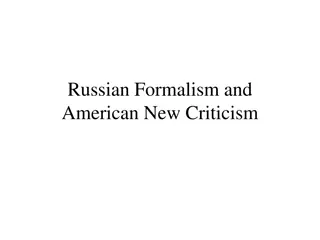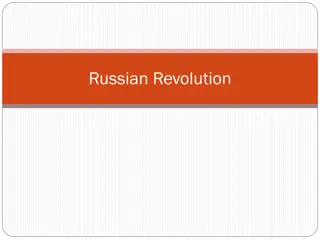
Digital Activity of Russian Enterprises: Pilot Surveys
The study explores the digital activity of Russian businesses through pilot surveys, aiming to compensate for the lack of statistical information on emerging digital technologies. The research covers motivations, background, sampling methodologies, and criteria for indicator selection, shedding light on the opportunities and limitations in the digital economy.
Download Presentation

Please find below an Image/Link to download the presentation.
The content on the website is provided AS IS for your information and personal use only. It may not be sold, licensed, or shared on other websites without obtaining consent from the author. If you encounter any issues during the download, it is possible that the publisher has removed the file from their server.
You are allowed to download the files provided on this website for personal or commercial use, subject to the condition that they are used lawfully. All files are the property of their respective owners.
The content on the website is provided AS IS for your information and personal use only. It may not be sold, licensed, or shared on other websites without obtaining consent from the author.
E N D
Presentation Transcript
Center for Business Tendency Studies THE DIGITAL ACTIVITY OF RUSSIAN ENTERPRISES: THE FIRST RESULTS OF PILOT SURVEYS Liudmila Kitrar, Inna Lola 9th JOINT EC/OECD WORKSHOP ON RECENT DEVELOPMENTS IN BUSINESS AND CONSUMER SURVEYS 1
Content Motivation and background Methodology indicators system, sampling The results of the first pilot survey in manufacturing levels and changes of digital activity expected benefits and limitations digital technologies in industries with different technological level Innovations in the pilot surveys in 2019 2
Motivation and background The lack of information on the digitalisation of the economy and society has a negative effect on the ability of a country to use all the opportunities offered by digital development In Russia, the official statistical evaluation of IT in business was launched in 2010 but it is still limited to monitoring first wave technologies: computerisation, process automation and telecommunications. Among the technologies of second and third waves Russian statistics covers cloud computing only No information on sectoral limitations usage of IT at the level of specific industries dividends on investment in digital technology Our aim - to compensate for the insufficiency of statistical information by collecting and summarising entrepreneurial opinions and intentions regarding emerging digital technologies, short and medium prospects in the digital economy, the potential benefits of introducing new digital solutions 3
Sampling and programme Survey of business tendencies and digital activity in manufacturing The sample covered 1150 companies Survey of business tendencies and digital activity in retail trade The sample covered 700 firms The first pilot surveys were conducted in mid-2018, the second in mid-2019 The survey programme is based on international experience in measuring digital progress: EC practice in digital agenda and conducting annual surveys of the information society European Digital Economy and Society Index (DESI) key blocks, construction methodology and results analysis National state programmes Digital Economy of the Russian Federation and Information Society Development Strategy in the Russian Federation for 2017-2030 4
Criteria for indicators selection Surveys indicators are supposed to be: consistent with the methodology of BTS conducted over the past 20 years in Russia and reflect the level and main trends in digital activities simple, recognisable and understandable to respondents and users formulated in line with national quantitative analogues and targets of programs for the development of the digital economy as close as possible to international counterparts all information is of a qualitative nature 5
The indicator system Performance indicators: key trends characterising the business climate Digital manufacturing market: the stage of digital development, the current and expected levels of digitalisation, the impact of digital technologies on production, the availability of a strategy for digital technology development The level of digital technologies implementation Dividends on investment in digital technology Human resources/digital skills Main limiting factors 6
Technology classification Classification of manufacturing industries by the level of technology Medium- and high-tech production Low-tech production Manufacture of chemicals and chemical products Manufacture of textiles CH T Manufacture of basic pharmaceutical products and pharmaceutical preparations Manufacture of wearing apparel PH W Manufacture of computers, electronic and optical equipment Manufacture of leather and leather products C L Manufacture of electrical equipment C&RP Manufacture of coke and refined petroleum products E Manufacture of machinery and equipment not elsewhere classified M&E R&P Manufacture of rubber and plastic products Manufacture of basic metals BM Manufacture of motor vehicles, trailers and semi-trailers M Manufacture of fabricated metal products, except machinery and equipment Manufacture of furniture FM F The classification was developed by UNIDO and recommended for use in the CIS countries 7
Results: digital activity Digital activity Digital strategy the share of respondents who mentioned each position, % 8
Results: the levels and changes of digital activities Digital activities: Electronic exchange of information inside the enterprise Use of personal computers and other portable devices Access to the Internet and the use of the Internet for business purposes Electronic exchange of information with other enterprises (suppliers/consumers) Electronic billing Investments in digital technology The number of employees in the field of digital technologies E-commerce turnover Cloud services RFID technology The modest positive trends in the digital activity indicators The bigger markers represent current changes in the first half of 2018, the smaller markers expectations for the first half of 2019 9
Results: benefits and limiting factors Factors limiting the digital transformation The expected benefits of investment in digital technology the share of respondents who mentioned each position, % 10
Results: digital technologies in various industries. Low-tech industries (LT) Medium and high-tech industries (MHT) C Computers, electronic equipment E Electrical equipment M Motor vehicles M&E Machinery & Equipment CH Chemicals PH Pharmaceutical T Textiles W Wearing apparel L Leather products C&RP Coke & Refined petroleum R&P Rubber & Plastic BM Basic metals FM - Fabricated metal products F Furniture 11
Results: expected effects of digital investment Low-tech industries (LT) Medium and high-tech industries (MHT) Manufacturing defects Customers expansion Manufacturing defects Customers expansion Labour productivity Production growth Labour productivity Customer service Competitiveness Production growth Customer service Competitiveness Profits increase Cost reduction Environmental Profits increase Robotisation Cost reduction Environmental friendliness Robotisation friendliness decrease decrease Fabricated metal products Machinery and equipment Basic metals Pharmaceuticals Coke and refined petroleum Motor vehicles Rubber and plastic Electrical equipment Leather products Computers, electronic equipment Furniture Chemicals Textiles The benefits mentioned by a relatively larger share of respondents are recognized as more significant (a long arrow), a relatively medium share moderately significant (a middle length arrow), a relatively small share less significant (a short arrow) Wearing apparel 12
First pilot survey in manufacturing: Conclusions Many projects on digital transformation were in the development stage and required investment Most of the digital activity indicators showed modest positive trends The following IT areas were developed successfully: the use of personal computers and portable devices Internet access and Internet use for business purposes electronic information exchange Digitalisation was constrained by weak investment activity The main expected benefits from investments in digital technologies: increase in productivity and competitiveness costs reduction Industrial IoT, intellectual robotic systems and manufacturing analytics are most common in the MHT industries 13
Innovations in the pilot survey-2019: Greening. The experimental set of questions about the use of digital technologies in enterprises for the sustainable inclusive green growth: Does your company use digital technologies to increase environmental and resource efficiency in the region in the following areas: improving energy efficiency creating clean and safe energy improving the efficiency of water and raw materials increasing carbon efficiency reduction of greenhouse gas and pollutant emissions transition to renewable energy sources recycling expansion of the electric vehicle fleet The set of questions is experimental and will be revised after obtaining the results of the pilot survey 14
Innovations in the pilot survey-2020: Composite indicators. Experimental composite indicators summarising the qualitative information: Digital Climate Index is the average of the respondents opinions on the levels and tendencies (current and expected) of demand for digital technologies, labour productivity, firms competitiveness, economic situation, and the number of employees. The weighted normalised sum of these indices for various economic activities will reflect the dynamics of aggregate digital sentiment of business in Russia Digital Accessibility Index is the arithmetic mean of the assessments of usage (in levels) and/or expected implementation of all digital technologies listed in the questionnaire Digital Dividends Index combines estimates regarding the level of dividends The combination of these three indices will allow us to rank the manufacturing activities with a different technological level and identify digital inequality between industries All survey programs and procedures for information aggregation are experimental; they will be tested and confirmed or modified for the final selection of relevant composite indicators 15
Thank you for your attention! tlipkind@hse.ru 16






















